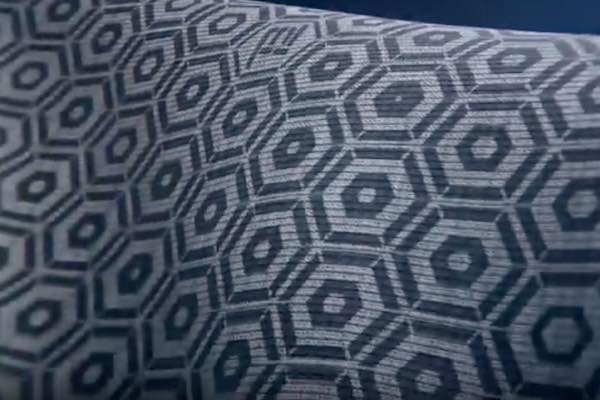
[Image above] Credit: Under Armour; YouTube
I already provided a taste of several of the tech advances from the Consumer Electronics Show 2017 that were made possible with ceramic and glass materials, but I missed an interesting one—Tom Brady’s pajamas.
Yes, you read that correctly—his pajamas.
Athletic apparel maker Under Armour unveiled a bioceramic-laden line of sleepwear at CES 2017, touting the line’s endorsement by famed U.S. football player Tom Brady.
Under Armour’s athletic recovery sleepwear is made from a fabric printed with ceramic particles that absorb the body’s heat and radiate it back as far infrared energy—which claims a variety of health benefits.
According to Under Armour’s website, “The soft bioceramic print on the inside of the garment absorbs the body’s natural heat and reflects far infrared back to the skin. This helps your body recover faster, promotes better sleep, reduces inflammation, and regulates cell metabolism.”
The apparel is now available for sale on Under Armour’s website, although it’s not cheap to restore your body while you sleep—individual items (tops and bottoms sold separately!) cost $80–$100.
Credit: Under Armour; YouTube
But come on—a bioceramic print that can restore your body while you sleep? It sounds all too similar to those kitschy body-healing bracelets.
According to an article in Time, “Under Armour is certain the product works. ‘We’ve tested it,’ says Kevin Haley, UA’s president of innovation. ‘We’ve had actual third party testing. And it’s clear. Believe me, we have some of the biggest skeptics in the world running around here. This isn’t some outlandish thought, this is something people have been working on for a long, long time. We’ve had our best Ph.D. scientists here breaking down all the science. It definitely works. When you say ‘how confident are we?’ I’m confident saying we’re very confident.’”
And, surprisingly, he may be right.
First of all, ceramics do emit infrared radiation. Actually, most all objects emit infrared energy—ceramics are just really good at it.
But does infrared radiation affect living cells?
Yes—far infrared energy is absorbed by water molecules within cells and tissues, causing local temperature changes that alter the membrane potential of cell membranes. And because the membranes govern a vast majority of cellular functions, changing the membrane potential provides the ability to influence many cellular processes.
But does infrared radiation have positive health benefits?
Well, maybe. There actually is a decent amount of preliminary medical research on the health benefits of far infrared radiation.
Studies have indicated that far infrared radiation can increase microcirculation and reduce inflammation to promote healing, cell proliferation, and cell viability.
But the results from these studies are still somewhat preliminary, because many of them have been done on cultured human cells in the lab or in animal models—which, while they are valuable indicators, only provide conjecture on whether the same might hold true in living, breathing humans.
And while there has been a fair number of clinical trials on the effects of far infrared radiation in living, breathing humans, the nature of medical research is that the results of these studies provide no certain answers.
Take for example, this previous study that also examined the effect of pajamas with small embedded ceramic disks. Individuals in the study reported “improvement of their health” after using the disks—but what specific conclusions can be made from such a subjective report?
A more recent review seems to echo the overall sentiment—while there is evidence to indicate there are benefits to far infrared radiation, more research is needed to really prove the effects and the ways in which infrared radiation specifically affects the body.
However, some studies do suggest there are specific metabolic benefits for athletes who wear bioceramic clothing. Far infrared-emitting ceramic clothing reduced the amount of oxygen cyclists consumed during physical exertion, although the statistically significant difference was small—just ~1%.
So it is plausible that bioceramics that emit far infrared energy could help restore your body as your sleep. It’s not going to heal a broken bone or repair a torn ligament, but infrared radiation could feasibly lend the body a helping hand in the ongoing repair and upkeep processes that happen during sleep.
Whether these fancy pajamas actually emit enough infrared radiation to make a difference remains a question, however.
Anyone want to drop $200 to do the experiment?
